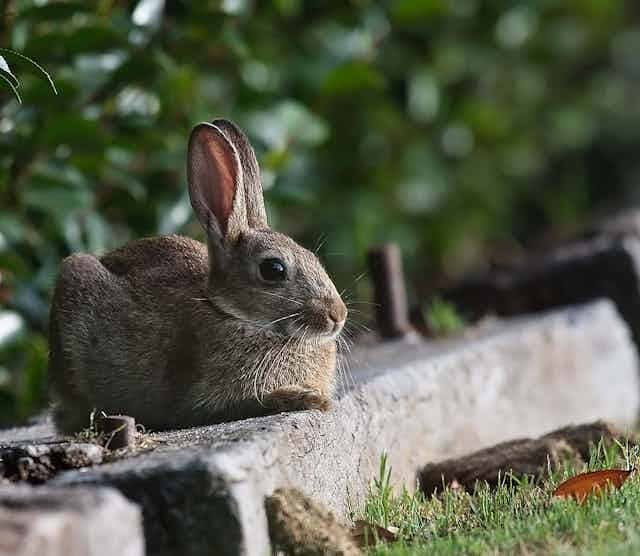Domesticated rabbits arrived in Australia with the first fleet and some became established as feral populations around colonial settlements as early as the 1830s. However, the situation changed dramatically on Christmas Day 1859 when a dozen wild rabbits from the Liverpool area arrived in Port Phillip Bay aboard the brig Lightning.
Those rabbits were taken to “Barwon Park” (near Winchelsea Victoria) and carefully nurtured with the aim of having a new hunting resource. The introduction exceeded all expectations. When Prince Alfred, Duke of Edinburgh, visited in 1867 he shot 416 rabbits in a little over four hours.
As the rabbits spread beyond the limits of Barwon Park, consternation grew. Livestock production on some pastoral lands fell as much as 60% as the rabbits spread. Ways to control them became imperative.
The construction of rabbit-proof fences in Western Australia ranked among the more heroic attempts to stop the spread. The first fence took six years to complete and was eventually 1833km long. But it proved useless because rabbits were soon abundant on both sides. Two additional fences to the west were equally ineffective.
Although a whole arsenal of control methods was developed, including poisoning, barrier fencing, warren destruction and fumigation, few landholders persisted resolutely enough to keep rabbits out. Many used quick-acting poisons like strychnine-laced grain so they could collect the rabbits to skin and gain a little money to offset foregone livestock production. This had terrible consequences for native wildlife and did nothing to solve the chronic rabbit problem.
Most interestingly, some people in the colonies were considering far more advanced answers to the problem. In 1890 an inter-colonial Commission, including New Zealand representatives, offered £25,000 for anyone who could provide a solution.
It was an enormous amount of money for the time. Even the great Louis Pasteur responded by dispatching Adrienne Loire to Australia armed with vials of chicken cholera bacteria (Pasturella multocida). But, although lethal, the bacteria did not spread from rabbit to rabbit and so fell short of solving to the problem.

Even so, the concept of a biological control agent for rabbits had been firmly established. When Dr de Beaurepaire Aragào suggested from Uruguay in 1919 that a myxoma virus from the South American brush rabbit offered another possibility, the idea was immediately promoted. But field experiments, begun in the 1930s after much debate, indicated little likelihood of success. World War II also interrupted the work and 1950 saw what might have been the last of a series of investigations in the New South Wales Riverina area. Disappointingly, the disease spread slowly then apparently ground to a stop as summer approached. The researchers left to spend Christmas with their families.
Nonetheless, that was by no means the end of the story. CSIRO’s Bernard (Bunny) Fennessy, who worked on the project, once told me that his Christmas break in Melbourne was suddenly disrupted by a telegram requesting him to quickly return to the Riverina because rabbits were reportedly dying in huge numbers. Indeed it was true. Mosquitoes, unusually common owing to heavy rains, had carried the disease well beyond the experimental sites. The results were astounding. The numbers of rabbits fell by over 90%, and Australia’s rabbit problem seemed resolved overnight.
Over time, however, rabbits developed some disease resistance. As numbers increased landholders had to do more poisoning and warren ripping. This also stimulated further research work, resulting in the introduction of rabbit fleas to better carry the virus, then the release of a calicivirus (Rabbit Haemorrhagic Disease Virus or RHDV) to maintain a high level of rabbit control.
Awareness of the rabbits’ environmental impacts, previously badly neglected, was also growing. We now know that rabbits are degrading and seriously inhibiting the regeneration of many natural ecosystems. Rabbit browsing is a major threat to the regeneration of endangered buloke-pine woodland in north-western Victoria. Rabbits need to be kept at less than one rabbit to two hectares if seedlings are to survive and replenish the ageing tree population.
Fortunately, with advances in rabbit control we can ensure that rabbits are effectively managed and environmental goals can be met. The big surprise, however, is that conservation often requires a far higher level of rabbit control than the prevention of economic losses in livestock production.
Casting back to Christmas Day in 1859, it has been a long battle to retrieve the situation and make major gains against the rabbit. Our viral Christmas present of 1950 provided the turning point. Economically, Australia’s meat and wool industries have benefited to the equivalent of $70 billion (2011 A$) since then and we are in a good position to reduce rabbit impact in conservation areas. However, we cannot become complacent and on-going work is needed to maintain those advantages.

